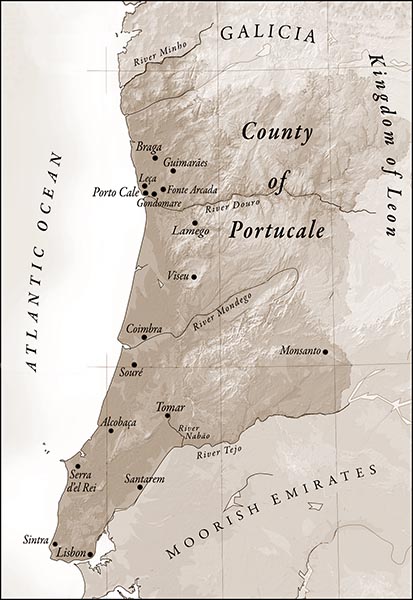THE GREATEST STORY NEVER TOLD.
How the Knights Templar created Europe's first nation-state and a home for the Grail. Pt. II


Based on material from First Templar Nation by Freddy Silva. ©2014. No unauthorized reproduction or sharing please.
While Mendes groomed Afonso for his future role as first king of the Portuguese, the Templars continued to amass properties in and around Braga, and inevitably the city became their headquarters, as one Templar Master asserted: “De Domo Templi, quest est in Bracharensi Civitate,” ‘the home of the Temple, which is in the city of Braga’. The rate at which they received properties on Portuguese soil far eclipsed donations given to the Order elsewhere in Europe, and particularly so around the end of 1125. In the late part of that year the Templars grew noticeably active on Temple Mount, with several knights returning to Europe, as evidenced by the appearance at the Cistercian abbey in Clairvaux of the knights André de Montbard and Brother Gondemare — the former being the uncle of Bernard de Clairvaux, and the latter a Cistercian monk from the Portuguese town of Gondemare, a few miles south of Braga.
They were by no means the only knights stirred into action by Hugues de Payns. On the Celtic pagan day of Beltane, May 2, 1125, the Templar Grand Master co-signed a document in which he and Prior Arnaldo of the Order of Sion once more declared good relations between their respective brotherhoods, after which the prior also becomes suspiciously absent from Jerusalem. Writing of this notable event, the chronicler Lucas de Santa Catarina states how “the Grand Master dispatched several knights with powers to establish the Portuguese crown. Four of the Knights were Dom Guilherme, who supervised the others, Dom Hugo Martiniense, Dom Gualdino Paes, and Dom Pedro Arnaldo. They had the title and the power of Procurators of the Temple, which they exercised in due course, as many writers agree, while the Order sought to establish a home, and proceed as planned.” Joining them on the voyage to Portugale was a fifth Templar Procurator, Raimund Bernard.
No doubt Brother Gondemare and André de Montbard shared this explosive piece of news with Bernard de Clairvaux at his abbey. And yet to the Cistercian abbot this was hardly news, merely confirmation. Bernard had been contemplating the idea of establishing a temporal New Jerusalem, a model nation-state that would come to represent the epitome of true Christian ideals, because back in 1119 Bernard himself had dispatched a delegation of monks from Clairvaux to the Portuguese county — domain of his late uncle Count Dom Henrique — to found a monastery. One of those eight monks was Brother Roland, one of the founder Templar knights.
Given these associations between the Cistercian monks and the core Templar brotherhood it can be argued that both the Templars and Cistercians were working toward the same end — not to mention the Ordre de Sion, for not only was their abbot now also a Templar Procurator, and Portuguese at that, but brothers Gondomare and Roland are also listed as members of that same order.
No sooner had the five Templar Procurators landed in Portugale in 1125 when they received the first of many property donations: a small town near Gondemare called Fonte Arcada. The document was witnessed and signed, “I, Guilherme, Procurator of the Temple in this territory, receive this document.” But this Guilherme Ricard was far more than that, for his name appears on a second grant — for half the estate of Villa-nova donated “to God, and the brotherhood of the Knights Templar” — this time in Latin as Magister Donus Ricardus. Guilherme Ricard was the first Master of the Knights Templar in Portugale.
All these events preceded the Templars’ official blessing by the Pope at the Council of Troy in 1128. And barely two months after the famous event, Portugal’s independence was secured by prince Afonso Henriques, son of the late Count Dom Henrique. That the Templars were central to this event is shown in the declaration document which bears the first-known Templar logo.
But there’s more. Just as the first two kings of Jerusalem were “greatly obligated” to the Order of Sion for their positions, so prince Afonso was said to be “greatly obligated to members of the Order [of the Knights Templar].” This relationship became all too clear in 1129 when the king-in-waiting reissued the charter for the castle of Souré, — the one his father had donated to the Templars before they were thought to exist. Afonso’s wording on the reconstituted charter to the Knights Templar unequivocally reveals why he was so “greatly obligated” to the order: “I make this donation, not by force or by persuasion, but for the love of God, and for the good of my soul, and of my parents, and by the cordial love that I have for you, and because within your Brotherhood and in all your works I am a Brother.”
The Templars had placed one of their own on the throne of Portugal, and more to the point, Afonso was also the nephew of their main benefactor and spiritual compass, Bernard de Clairvaux.
Continue to part III
Return to Articles